|
- Interim Update 4th March 2009
Copyright
Reminder
The commentaries that appear at TSI
may not be distributed, in full or in part, without our written permission.
In particular, please note that the posting of extracts from TSI commentaries
at other web sites or providing links to TSI commentaries at other web
sites (for example, at discussion boards) without our written permission
is prohibited.
We reserve the right to immediately
terminate the subscription of any TSI subscriber who distributes the TSI
commentaries without our written permission.
Basic economics: the economy can't get something for nothing
Due to the way economics is generally portrayed in the mainstream
press, much of what we say on the subject at TSI probably seems
counter-intuitive to our readers. However, our arguments should appear
less 'off the beam' if you put aside everything you are continually
being told by mainstream pundits and rely solely on common sense. For
example, it should be intuitively obvious that the government can't
increase wealth or strengthen the economy by creating money out of
nothing, and that the only way the government can increase its own
spending is to take, by some means or other, more money from the
private sector. It should also be intuitively obvious that after way
too many resources have been channeled into one part of the economy
(housing, in the current situation) and the amount of savings has
fallen to a dangerously low level, you can't make things better by
channeling even more resources into the over-invested sector and by
encouraging people to further reduce their savings.
Most people probably sense that there is something very wrong with the
economic remedies that are being proposed and implemented by the
governments of today, but just can't put their finger on exactly what
it is. After all, the idea that one person's spending is another's
income seems correct, so why exactly wouldn't it do any good to bring
about an increase in spending? Why wouldn't an increase in spending
prompt an increase in production and thus get the whole economy growing
at a more normal rate?
In an effort to remove some mud from the water we will now consider two
hypothetical situations, the first of which begins with the US
Government giving money-printing machines to every adult in the US
economy. These machines are designed to create paper dollars that are
indistinguishable from the official Federal Reserve Notes, but they are
only able to create $20,000 of new money every 12 months and they are
given out on the proviso that the recipients spend all the new money.
How does this affect the economy?
There is naturally a dramatic increase in spending, but the new money
is not spread evenly throughout the economy. As a result, some consumer
goods experience large price gains whereas the prices of other consumer
goods are initially unaffected. For instance, the residential housing
market is largely unaffected because few people use the $20,000 to make
a down-payment on a new house, but the prices of restaurant meals,
clothing, drugs and education get significant boosts.
Entrepreneurs then react to price signals and begin to increase
investment in those parts of the economy that are the greatest initial
beneficiaries of the new money. Note, though, that the money-printing
machines have not created any additional resources, so the investment
prompted by the new money causes resources to be shifted away from some
areas and into other areas. This, in a nutshell, is how the market
economy continually adjusts itself in response to price information.
The problem in this case is that the price information upon which
numerous new investments are predicated is not 'real' -- it is solely
the result of the new money.
After a while, the effects of the new money are being seen throughout
the entire economy and the government starts getting worried about
inflation. The government is then faced with a choice -- let the
inflation problem grow and potentially risk a hyperinflationary
breakdown, or put a stop to the money-printing. It begrudgingly chooses
the latter option and takes back its printing machines, thus ending the
inflation. The thing is, the money printing caused a huge quantity of
savings/resources to be allocated to activities that would only remain
viable if the inflation continued. The reduction in the money printing,
which was absolutely necessary to avoid a complete monetary breakdown,
thus shines a spotlight on the mal-investments that occurred in
response to the preceding high-inflation environment. The prices of
these mal-investments tank and a severe economic downturn then begins
as the economy tries to re-build savings and bring production back into
line with sustainable consumption. The government, under the influence
of its Keynesian and Fisherian advisors, then tries to curtail the
adjustment process and gives out a new bunch of money-printing machines
-- this time, machines that are capable of printing $30,000/year of new
money.
The result is that boom leads to bust and bust leads to boom, with the
economy getting further and further 'out of whack' with each cycle.
In the real world the government doesn't hand out money-printing
machines, but the same effects occur when the central bank and the
commercial banks create money out of nothing.
To tie some concepts together let's now consider another hypothetical
situation, this time involving a baker who sells bread for $1 per loaf
and wants to buy two pairs of shoes, each of which costs $100. To buy
the first pair of shoes the baker produces and sells 100 loaves of
bread and then gives the proceeds of his bread sales to the shoemaker
in exchange for a new pair of shoes. In this case, the baker has paid
for his shoes by producing bread. He has taken something out of the
economy (a pair of shoes) and has put something of equivalent value
back into the economy (100 loaves of bread). In this case, one person's
(the baker's) spending is another's (the shoemaker's) income.
Our baker then prepares to produce another 100 loaves of bread to pay
for the second pair of shoes, but just as he is about to start work a
money-printing machine arrives from the government. There is no longer
any need for the baker to go to the trouble of producing 100 loaves of
bread because he can now just create $100 out of nothing. He therefore
cranks up his new money-printing machine, churns out $100 of new bills,
and then gives these new bills to the shoemaker in exchange for a pair
of shoes. In this case, the baker has paid for his shoes with NOTHING.
In essence, he has taken something out of the economy and put nothing
back into the economy. In this case, one person's spending is not
another's income because the shoemaker has received no real income; he
has, instead, received nothing in exchange for something.
Of course, our hard-working shoemaker doesn't realise that he has been
tricked into providing something for nothing because the dollar bills
handed to him by the baker look like every other dollar bill. He
therefore goes about his business and either spends or saves the $100
received from the baker as if it were real. He is not significantly
disadvantaged by the baker's successful attempt to get something for
nothing because the money provided by the baker to the shoemaker gets
merged with the total money supply. The cost of the baker's fraud is
therefore spread over the entire economy, meaning that the baker got
something for nothing but the economy became slightly worse-off as a
result.
If the only exchange of nothing for something were the $100-exchange
between our hypothetical baker and shoemaker then the effect on the
overall economy would be negligible, but what if this type of
transaction were widespread, with people throughout the economy
regularly exchanging money created out of nothing for real goods and
services? It takes only a little common sense to realise that if a lot
of people within the economy are consuming (taking things out) without
producing (putting things back) then there will be a substantial
decline in the total amount of wealth.
Once you understand that increased consumption will lead to a LOSS of
wealth IF it is not funded by increased production you will see why
government stimulus packages not only can't help the economy, they must
hurt the economy.
The criticism leveled at the huge stimulus package recently put into
place by the Obama Administration has tended to be along the lines of
"it is not big enough" or "it won't do much good because it won't
result in a large enough boost to spending THIS year". This is terribly
flawed logic. The reality is that the greater the amount of the
"stimulus" and the faster it gets spent, the more HARM it will do.
The Stock Market
Current Market Situation
Either the post-crash rebound was a lot weaker and shorter than we were
expecting, or it hasn't begun yet. We suspect the latter.
Since the end of its secular bull market in March of 2000 the US stock
market has had a strong tendency to reach an intermediate-term extreme
in March of each year. As recently as two months ago we thought that if
March of 2009 was going to provide any sort of extreme it would be a
high (the culmination of the post-crash rebound), but it is now clear
that if there is going to be an important turning point this March it
will be a turn from down to up. In our opinion, this is a likely
outcome.
The S&P500 Index broke below its November-2008 low at the end of
last week and continued its decline over the first two days of this
week before bouncing on Wednesday. It is likely to reach an important
bottom this month, but there is no evidence that a bottom is already in
place.
Although the S&P500's recent performance suggests that some
additional downside will occur prior to the start of a tradable rally,
some sectors of the market have potentially just completed successful
tests of last year's lows. Examples are the airline and natural gas
sectors, which are represented on the following charts by the AMEX
Airline Index (XAL) and the AMEX Natural Gas Index (XNG).
The XAL had been making higher lows until mid February, at which point
it broke out to the downside and began to accelerate lower. This
decline was driven by weakness in the broad market, which, in turn, was
driven by fears of dramatic global economic weakness. Airline revenues
are obviously going to be a lot lower this year than they were last
year, but capacity and costs will also be a lot lower. Furthermore,
whether or not the airline stocks continue to decline will be
determined to a large extent by what the stock market has already
discounted.
By Tuesday of this week the relentless decline of the preceding three
weeks had taken the XAL back to its July-2008 low, but support defined
by this prior low has initially held.
The XNG is in a similar situation to the XAL in that it broke out to
the downside in mid February and plunged to, but not through, its 2008
low earlier this week. The XNG's decline has been driven by the general
stock market weakness and fears that the global economic downturn will
cause the natural gas price to fall to zero. Interestingly, bearishness
about natural gas equities might have reached a crescendo over the past
week, just as the natural gas price was showing tentative signs of
bottoming.
It is possible that the XAL and the XNG have just bottomed, but if not
we expect that important bottoms will be in place before the end of
this month.
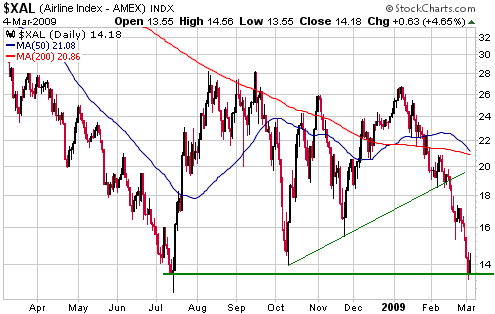

Gold and
the Dollar
Gold
Below is a daily chart of April gold futures.
Tuesday's break below support at $927 indicates that a short-term peak
was put in place at around $1000 late last month. However, the gold
price has now fallen for eight days in a row, which means that a
rebound should begin almost immediately.
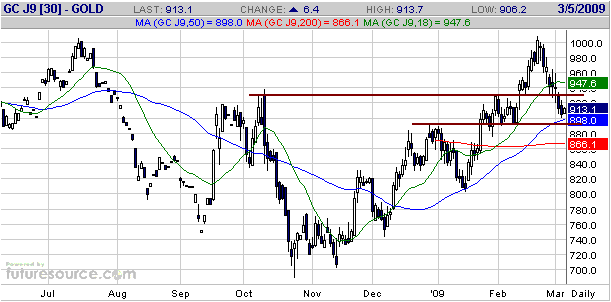
Although a rebound
should begin within the next day or so it is unlikely that the downward
correction has run its course. The reason is that the eight consecutive
down-days do not appear to have put a significant dent in bullish
sentiment. For example, at the close of trading on Wednesday the
Central Gold Trust (GTU) and the Central Fund of Canada (CEF), two
funds that invest in bullion, were priced at premiums of 20% and 10% to
their respective net asset values. These premiums are quite high and
are only about 2% below recent peaks.
In addition, if the long-awaited stock market rebound finally begins
later this month then the fears that have been boosting the gold price
will abate for a while.
Our thinking is that the gold market will spend a few months
consolidating below $1000 before resuming its advance. By the way, this
does not represent a change in our thinking in that we have not been
anticipating substantial upward progress on gold's part during the
first half of this year. For example, in the 9th February Interim
Update we speculated that the best gold would do over the coming two
months is test its 2008 peak, and when gold rose to the vicinity of its
2008 peak in late February we said that a pullback was very likely.
Things are happening a couple of months later than originally expected,
but the strength we have been waiting for in base metals relative to
gold appears to be getting underway. Note, for instance, that while
gold was falling for an eighth consecutive day on Wednesday the copper
futures market was surging to a 3-month high. A daily chart of March
copper is included below.
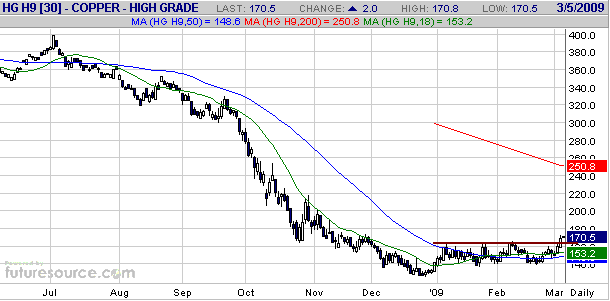
A multi-month
consolidation in the gold price within, say, the $800-$1000 range won't
necessarily end the rally in the gold sector of the stock market. The
reason is that gold stocks, especially the juniors, still have a lot of
catching up to do. The gold sector is the only sector of the stock
market that will report good earnings results over the next two
quarters, and the gold mining business is potentially much more
profitable today than it was when the HUI was peaking in March of 2008
or when the average gold stock was peaking in May of 2006.
Gold Stocks
As discussed in last week's Interim Update, the gold sector tends to
reach a short-term extreme during the first half of March. With the HUI
hitting a 6-week low on Tuesday of this week (3rd March) the stage is
now set for a short-term bottom during the first half of March-2009.
It's possible that the HUI reached its correction low on Tuesday when
it dropped to 260, but we won't be surprised if it drops a little
further over the days ahead and tests the support at 240-250
highlighted on the following chart. Investors who have been waiting for
an opportunity to increase their exposure to the gold sector should
take advantage of any weakness over the next several days.
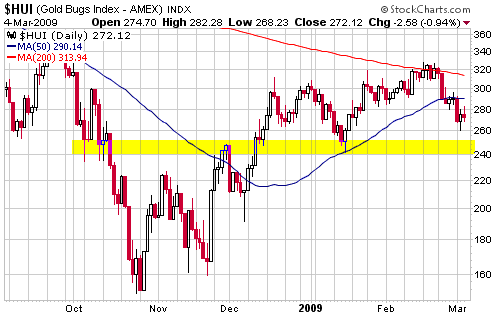
The total supply of
gold shares has increased substantially over the past three months due
to numerous equity financings. This shows that gold mining executives
generally don't have much confidence in the upward trend's
sustainability, which is not, in itself, a reason for us to be
concerned given that most gold mining executives fall into the 'dumb
money' category. Like the general public, they tend to be too bullish
near important tops and too bearish near important bottoms. However,
while it is unlikely that this additional supply will bring the
sector's advance to a premature end it will exacerbate the next
intermediate-term correction.
Currency Market Update
With the broad stock market seemingly headed for a March low it would
make sense if the Dollar Index were headed for a March high considering
that there has been an inverse correlation between the two markets over
the past seven months.
The following chart comparison illustrates one argument in favour of a
March high for the Dollar Index. The chart compares the performance of
the Dollar Index during 2007-2008 (the top section of the chart) with
its performance during 2008-2009 (the bottom section of the chart) to
make the point that its performance from August-2008 through to the
present day has been the mirror image of its performance from
August-2007 through to March-2008. If this strange relationship
continues then the low of March-2008 will correspond with a high in
March-2009.
The relationship depicted below is not the sort of thing we would ever
risk money on, but we thought it was interesting that the dollar's
turning points of the past seven months line up so neatly with the
turning points that occurred exactly 12 months earlier. Also, the
relationship predicts an outcome that we think is likely based on other
considerations.
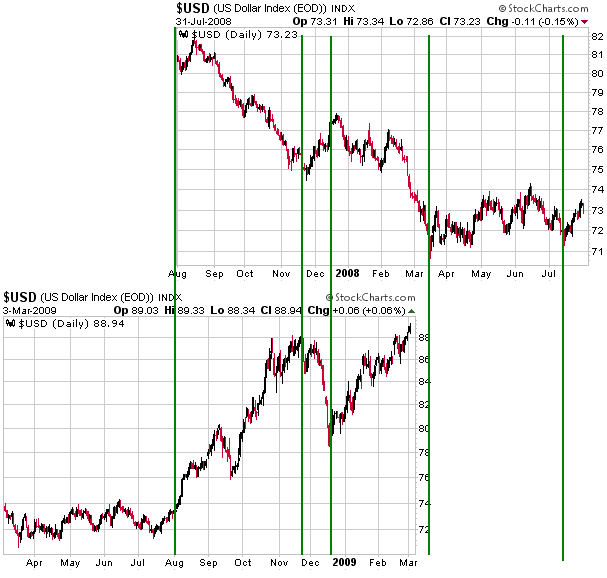
Update
on Stock Selections
(Note: To review the complete list of current TSI stock selections, logon at http://www.speculative-investor.com/new/market_logon.asp
and then click on "Stock Selections" in the menu. When at the Stock
Selections page, click on a stock's symbol to bring-up an archive of our comments on the stock in question)
 Lion Selection (ASX: LST). Shares: 82M. Recent price: A$0.85 Lion Selection (ASX: LST). Shares: 82M. Recent price: A$0.85
LST, an Australia-based gold-focused resource investment company, has a
net asset value (NAV) of A$1.66/share. This means that at its current
price LST is selling at a discount of almost 50% to its NAV. Moreover,
the NAV is based on conservative valuations of A$59M for LST's 30%
stake in the 100K-oz/year Cracow gold mine and A$12M for its 51% stake
in the development-stage Edna May gold project. According to the
project's Feasibility Study, Edna May is capable of producing 100K
ounces/year of gold at a cash cost of A$636/oz (US$413/oz). Edna May's
construction cost is estimated to be A$92M.
LST has a strong balance sheet (no debt, A$29M of cash) and is very
under-valued. It offers exposure to gold in a politically secure
location (Australia), and to other metals. It is, we think, a
reasonable candidate for new buying at this time.
 The NGD-WGW Merger The NGD-WGW Merger
New Gold (NGD) and Western Goldfields (WGW), both of which are members
of the TSI Stocks List, announced a business combination on Wednesday.
If it goes ahead as currently proposed, the combination will be
effected by NGD buying WGW in an all-stock deal (one new NGD share for
every WGW share).
The proposed merger makes some sense from NGD's perspective because
WGW's cash plus the cash flow generated by WGW's Mesquite gold mine
should, along with NGD's own cash, finance the remainder of the mine
construction at NGD's New Afton copper/gold project. However, we fail
to see how it makes any sense from the perspective of WGW shareholders.
For one thing, there is almost no premium in NGD's offer (whatever
small premium there is was created by the 'mysterious' 13% decline in
WGW's stock price on the day prior to the merger announcement). For
another thing, as one of the few junior gold miners with no significant
negative issues -- it has no operational problems, no
political/environmental risk concerns, and no need for additional
financing -- WGW was ideally positioned to attain a stock market
premium and to grow its business by acquiring development-stage gold
deposits.
In addition to the apparent lack of any good reason for the merger from
a WGW shareholder's perspective, the merger will reduce the number of
investment alternatives within the gold mining sector. We'd therefore
prefer that it didn't happen, but it almost certainly will happen as
currently proposed unless another company makes a better offer for WGW.
A better offer is a long shot, but isn't out of the question.
In the absence of a competing bid or speculation regarding a competing bid, NGD and WGW will trade in unison from now on.
As evidenced by the following chart, NGD has broken below its 50-day
moving average and short-term support. The chart therefore provides no
compelling reason to buy, but the stock is a good candidate for
accumulation near its current price based on valuation. Our worst-case
NGD valuation of US$3.00-$3.50 won't change as a result of the merger,
but the NGD-WGW combination is a lower-risk speculation than NGD on its
own.

Chart Sources
Charts appearing in today's commentary
are courtesy of:
http://stockcharts.com/index.html
http://www.futuresource.com/

|

